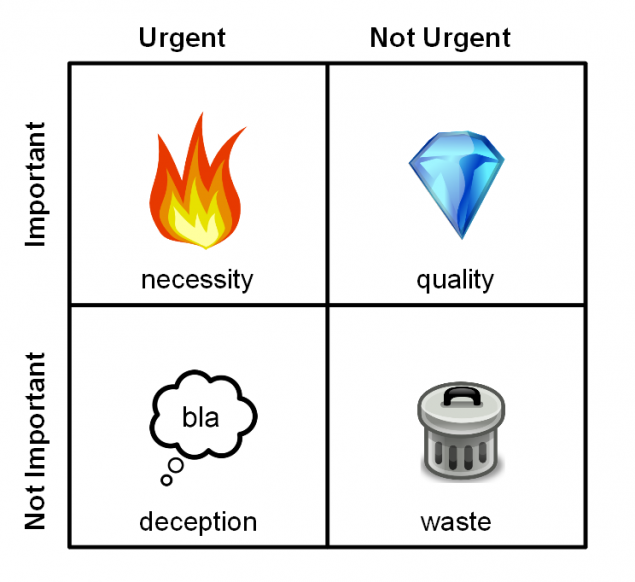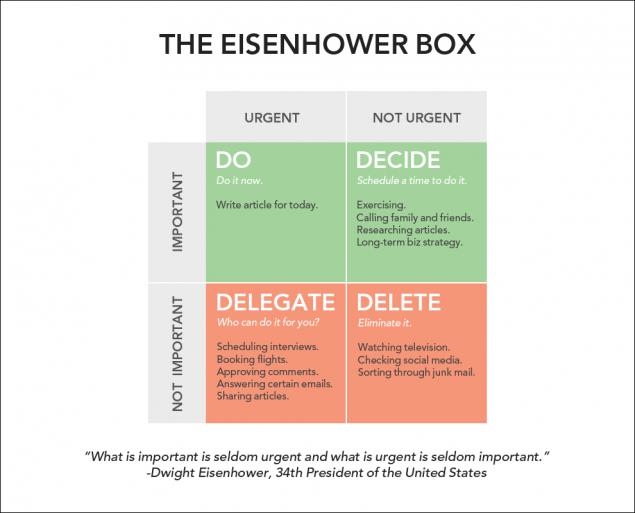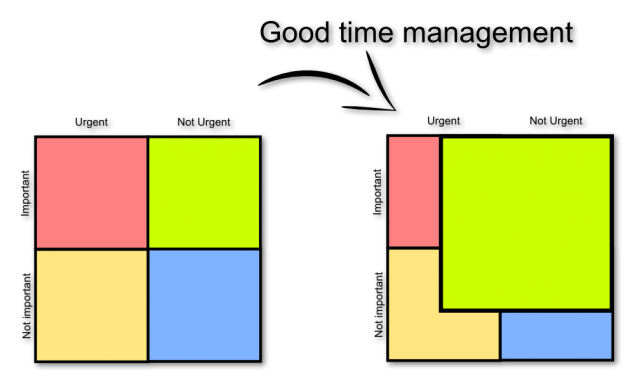2760
Goal-setting and monitoring activities on the basis of the matrix Eisenhower

We already wrote about how to cope with a stop on our way to achieving their goals fear and прокрастинацией . However, after we left the "dead zone" of inactivity and motivate yourself on the result, we can fall into the other extreme: after a long 8-12 hour day is impossible to say what, in fact, been done. And most importantly - what result from the effort we got? He promoted us to set goals?
As a result, easy to find yourself in a situation where "cool like a squirrel in a wheel," and things like standing still. Only accumulates fatigue. The feel of the reach heights never appears.
The problem of goal-setting
This problem has received in time management'e name "The problem целеполагания”. The consequences of errors in the goal-setting can be enormous: it seems that life becomes a series of grueling marathons working without visible results. This is similar to the work of the ancient Greek king Sisyphus, who was condemned after the death of racking up the mountain a huge stone, which nearly reached the summit broke back down. And so - ever.

The choice of objectives and priorities
Despite the fact that the problem of large-scale, and the consequences of her are complex and protracted nature, deal with it with it can be. To do this before starting any activity you need to properly set goals and priorities. How to do it we describe below, but now concentrate, please, on a single thought:
Do not proceed with the implementation of the planned tasks, if you can not answer the question of how and to what purpose you are promoting this or that task after its implementation. B>
Modus operandi "chaotic to do everything in a row" can be almost ideally suited to "make internal engine", "wake up" and start to do something. I usually used for this purpose housework - they are a set of fairly limited, to fulfill them immediately visible results and give up their performance in any case it would not be very comfortable. This activity is quite possible to do in "saw - made".
But when it comes to achieving the goals within the working draft, we have before us an almost unlimited scope for action, which means literally can engage in "anything". In the lack of time (namely, the resource we have always limited), this technique will be unproductive. Therefore, here we will save only the golden rule: "First think, then do."
Fast Targeting
Then the question arises: is there any effective method to "think fast" that it was not a problem for half a day? Yes, here it is appropriate to use a technique known almost everyone who has ever tried to figure out the time management and that we have learned in the post caps. This matrix Eisenhower. About her already written in other posts (they are more or less complete list at the end, we present our). However, we would like to offer a different way of using this matrix, which we have already used in practice.
Traditionally, the invention is credited matrix Dwight Eisenhower, the 34th president of the United States, which before was General of the Army. However, this is not true. Rather, the matrix has received its name from the famous quote President "Not all urgent matters are important, and not all the important things - urgent". I>
Matrix allows you to quickly and confidently enough to sort your case, even if a lot of them. All you need is to go through the list of cases (which you probably already "dumped" out of my head by the method GTD) and answer the two questions for each task:
Is it important? Yes \ No It's an emergency? Yes \ No

I must say, Eisenhower matrix has many names and in many ways was presented by different creators and adherents of time management systems. In particular, the famous author Stephen Covey GTD methodology matrix is called Urgency \ Importance matrix - it is also recommended to use it in his book "The 7 Habits of Highly Effective People." The same method is sometimes called a visual version of the "Rules of the four D" which will be discussed below. I>
How to deal with each quadrant
Many modifications of the matrix and a plurality of interpretations of how to proceed with the tasks in a particular quadrant. We will dwell on two options, the first of which seems to be the most convenient.
Method 1: Do-Plan-Delegate-Eliminate
"Do - Plan - Tasks - Do not do" - that will be heard this "formula for success" in the translation and that such action is necessary to perform the tasks of the respective quadrants.
Quadrant 1 i>
urgent and important. B> In this quadrant, something happens: a fire or a child crying or block release bug. This "bad" quadrant, it must, if possible, be avoided. Occasionally here you can "put" the problem of the second quadrant, which I would like to close immediately for some irrational reason.

Quadrant 2 i>
It is important, but not urgent. B> In this quadrant are your most productive business. As is the case with these things, "while suffering," here we are talking about intelligent design and quality execution of each task. This is something that is wise to spend some time just today.
You can start to do things in order, and you can again go through the list of cases of this quadrant asking the questions "Is it important?" And "It's an emergency?", Thus making another quadrant in the second quadrant and the more detailed your goals .
Quadrant 3 i>
It does not matter, but urgent. B> One of the most unproductive quadrants, as because of their urgency these cases "snatch" you out of your flow of productive activities and make you roll the stone up the hill without a goal. These cases do not promote you to put your goals, usually a different kind of information noise, such as rallies, many phone calls and conversations "about nothing" instead of decision-making. It is recommended to delegate these tasks to "someone else." You can delegate or not to do them, the main thing is that the case of this quadrant are not met in person.
Quadrant 4 i>
Do not rush and do not care. B> Just forget about these matters. Indeed, something must be able to say "no." Ideally, it is desirable that this quadrant have remained empty. However, it most often fall various requests from people who are unlikely to do something in response to you and dream from the category of "always wanted to find a yellow flower elephant on wheels and ride." Not every spontaneous desire to spend wisely, if you want to come to their targets.
Rule four D
In fact, "4D" is not always the quadrants of the matrix describes the "Important-Urgent", because There are a variety of treatments, however, one of which fits the above description and can also be applied to the four quadrants:
Do, Delegate, Defer, or Dump (Do Bands, delayed, BOAD)
Do, Decide, Delegate, Delete (Do decisive (in what order to do so), charging, remove)

The main charm of the method - its speed. Firstly, it represents "Statistics Task" visually. You can immediately evaluate the effectiveness of the use of their time resources. Secondly, answering yes or no just two questions, you share all tasks into 4 groups. If before you initially given the task of "divide your tasks into 4 groups," it would have taken much longer.
Check the effectiveness

You can use the method Eisenhower not only to sort tasks into those that move you toward the goal, and those that hinder. You can also use it to assess its overall effectiveness. Ideally, after a long time, you do not hesitate to answer "yes and no" to the two already known issue for each task, you will find that almost all of your tasks "fell" in the second quadrant.
But of course, most do not, and then the matrix clearly shows where you are and where you skew risk to be at the end of the day, if you do not switch on productive tasks.
To use this method already has a considerable number of mobile, web and desktop software. And for setting their goals and achieve them you have a service SmartProgress , which has helped bring 10,000 more goals. And what is the purpose - your?

Other posts about Eisenhower matrix
SCRUM board + Quadrant Eisenhower for product management
Antiavralnye solutions
Key points in time management
Overview of software for managing tasks in Outlook
Time Management in practice
Management Tools: 16 concepts for each day
Time Management - it's really just how important and urgent it was to read this post? 1st quadrant: if I had not read this post, something would happen. 2nd quadrant: it was not urgent, but it is important. Thank you for text. 3rd quadrant: it was hot, but it does not matter. You owe me 10 minutes of my time. 4th quadrant: it was not urgent and not important. I do not know why I read it. Only registered users can vote in polls. Sign , please. 169 people voted. 30 people abstained.
Source: habrahabr.ru/company/smartprogress/blog/245587/
Roscomnadzor begins the hunt for "the fake" accounts in social networks
Lydia Romanets. During the eight years in the business mask "indifference" to me has grown. With blood detached.























